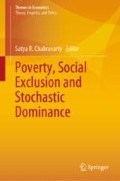Abstract
The objective of this paper is to derive some integer-majorization results for variable-sum comparisons. We use an axiomatic framework to establish equivalence between several intuitively reasonable conditions. © 2011 Elsevier Inc. All rights reserved.
Elsevier has been kind enough to allow reprinting of this article published in Journal of Economic Theory, Volume, 147, 2012. Elsevier’s permission in this context is acknowledged with sincere gratitude.
Access this chapter
Tax calculation will be finalised at checkout
Purchases are for personal use only
Notes
- 1.
- 2.
For simplicity, we restrict attention to a fixed population set up. But our results can be extended easily to the variable population case under the assumption of replication invariance of the evaluation function in the spirit of Dasgupta et al. (1973).
- 3.
This implication can be obtained as follows: note that the NIME axiom posits that
$$ E^{n} (x_{1} , \ldots ,x_{j} + 1, \ldots ,x_{i} , \ldots ,x_{n} ) - E^{n} (x_{1} , \ldots ,x_{j} , \ldots ,x_{i} , \ldots ,x_{n} ) $$$$ \ge E^{n} (x_{1} , \ldots ,x_{j} , \ldots ,x_{i} + 1, \ldots ,x_{n} ) - E^{n} (x_{1} , \ldots ,x_{j} , \ldots ,x_{i} , \ldots x_{n} ) $$while if \( x = T_{\text{MIME}} (y) \), then the conditions \( E^{n} (x) \ge E^{n} (y) \) is
$$ E^{n} (y_{1} , \ldots ,y_{j} + 1, \ldots ,y_{i-1} , \ldots ,y_{n} ) \ge E^{n} (y_{1} , \ldots ,y_{j} , \ldots ,y_{i} , \ldots, y_{n} ) $$Subtracting \( E^{n} (y_{1} , \ldots ,y_{j} , \ldots ,y_{i} - 1 \ldots ,y_{n} ) \) from both sides of the second inequality, we obtain the NIME axiom requirement if \( y_{i} - 1 = x_{i} \) and \( y_{k} = x_{k} \) for all \( k \ne i \).
References
Aboudi, R., & Thon, D. (1995). The duality approach to stochastic dominance with standardized random variables. Mimeo.
Aboudi, R., & Thon, D. (2006). Refinements of Muirhead’s lemma and income inequality. Mathematical Social Sciences, 51, 201–216.
Akerlof, G. A. (1997). Social distance and social decision. Econometrica, 65, 1005–1027.
Allison, R. A., & Foster, J. E. (2004). Measuring health inequality using qualitative data. Journal of Health Economics, 23, 505–524.
Atkinson, A. B. (1970). On the measurement of inequality. Journal of Economic Theory, 2, 244–263.
Atkinson, A. B. (1998). Social exclusion, poverty and unemployment (pp. 1–20). CASE/4, Centre for Analysis of Social Exclusion, London School of Economics.
Bossert, W., & Fleurbaey, M. (2002). Equitable insurance premium schemes. Social Choice and Welfare, 19, 113–125.
Chakravarty, S. R., & D’Ambrosio, C. (2006). The measurement of social exclusion. Review of Income and Wealth, 52, 377–398.
Dasgupta, P., Sen, A. K., & Starrett, D. (1973). Notes on the measurement of inequality. Journal of Economic Theory, 6, 180–187.
Deineko, V. G., Klinz, B., & Woeginger, G. J. (2009). The complexity of computing the Muirhead–Dalton distance. Mathematical Social Sciences, 57, 282–284.
Fishburn, P., & Lavalle, I. H. (1995). Stochastic dominance on unidimensional grids. Mathematical Operations Research, 20(3), 513–525.
Hardy, G. H., Littlewood, J. E., & Pólya, G. (1934). Inequalities. Cambridge: Cambridge University Press.
Kolm, S. C. (1969). The optimal production of social justice. In J. Margolis & H. Guitton (Eds.), Public economics (pp. 145–200). London: Macmillan.
Levy, H. (2006). Stochastic dominance. Investment decision making under uncertainty (2nd ed.). New York: Springer.
Marshall, A. W., & Olkin, I. (1979). Inequalities: Theory of majorization and its applications. New York: Academic Press.
Milne, F., & Neave, E. (1994). Dominance relations among standardized variables. Management Science, 40(10), 1343–1352.
Muirhead, R. F. (1903). Some methods applicable to identities and inequalities of symmetric algebraic functions of letters. Proceedings of the Edinburgh Mathematical Society, 21, 144–167.
Rothschild, M., & Stiglitz, J. E. (1970). Increasing risk: I. A definition. Journal of Economic Theory, 3, 225–243.
Rothschild, M., & Stiglitz, J. E. (1973). Some further results on the measurement of inequality. Journal of Economic Theory, 6, 188–204.
Savaglio, E., & Vannucci, S. (2007). Filtral preorders and opportunity inequality. Journal of Economic Theory, 132, 474–492.
Shaked, M., & Shanthikumar, G. (2006). Stochastic orders. New York: Springer.
Shorrocks, A. F. (1983). Ranking income distributions. Economica, 50(2), 3–17.
Weymark, J. A. (1981). Generalized Gini inequality indices. Mathematical Social Sciences, 1, 409–430.
Weymark, J. A. (2003). Generalized Gini indices of equality of opportunity. The Journal of Economic Inequality, 1, 5–24.
Yaari, M. E. (1987). The dual theory of choice under risk. Econometrica, 55, 95–115.
Acknowledgements
For comments and suggestions, we are grateful to two referees, an associate editor of this journal, Vincenzo Denicolò and participants of the JET Symposium on “Inequality and Risk”, Paris, June 25–26, 2010. Chakravarty thanks the Bocconi University, Milan, Italy, for support. Financial support from the Italian Ministero dell’Istruzione, dell’Università e della Ricerca (Prin 2007) is gratefully acknowledged by Claudio Zoli.
Author information
Authors and Affiliations
Corresponding author
Editor information
Editors and Affiliations
Rights and permissions
Copyright information
© 2019 Springer Nature Singapore Pte Ltd.
About this chapter
Cite this chapter
Chakravarty, S.R., Zoli, C. (2019). Stochastic Dominance Relations for Integer Variables. In: Chakravarty, S. (eds) Poverty, Social Exclusion and Stochastic Dominance. Themes in Economics. Springer, Singapore. https://doi.org/10.1007/978-981-13-3432-0_13
Download citation
DOI: https://doi.org/10.1007/978-981-13-3432-0_13
Published:
Publisher Name: Springer, Singapore
Print ISBN: 978-981-13-3431-3
Online ISBN: 978-981-13-3432-0
eBook Packages: Economics and FinanceEconomics and Finance (R0)

